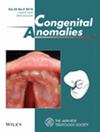Novel variants in the PAX6 gene related to isolated aniridia
IF 1.6
4区 医学
Q3 PEDIATRICS
引用次数: 0
Abstract
Aniridia, which is a rare congenital defect of the eye, consists of iris hypoplasia or aplasia, and additional ocular abnormalities. It is most commonly caused by autosomal dominant PAX6 gene mutations. However, in about 30% of cases, it is associated with chromosomal rearrangements in the 11p13 region. The aim of this study was to identify the potential PAX6 gene variants, which could cause the isolated aniridia. Eight patients with isolated aniridia were included in this study. MLPA analysis allowed in the past to exclude large structural rearrangements of the PAX6 and adjacent genes like WT1. Blood samples were collected from the patients (and their families in familial cases) and genomic DNA was extracted from peripheral blood leukocytes and buccal cells. The amplification of the 11 exons of the PAX6 gene was performed. Bidirectional Sanger Sequencing was conducted for the identification of the potentially pathogenic variants, and for the segregation analysis of the identified variant in the family. The results were analyzed with the use of CodonCode Aligner software. In three patients, aniridia was sporadic, whereas in another five cases, the eye defect was familial. The potentially pathogenic variants in the PAX6 gene were found in 6 out of 8 patients with aniridia. We identified four known (c.781C > T, c.607C > T, and c.949C > T twice), and two novel variants (c.258_265del and c.495_496insG). Point mutations in the PAX6 gene are the most frequent cause of aniridia. The investigation of the genetic background of the disease is essential for patients to evaluate recurrence risk in the offspring.PAX6基因与分离性无虹膜相关的新变异
无虹膜是一种罕见的先天性眼睛缺陷,包括虹膜发育不全或发育不全,以及其他眼部异常。最常见的是由常染色体显性PAX6基因突变引起的。然而,在大约30%的病例中,它与11p13区域的染色体重排有关。本研究的目的是鉴定可能导致分离性无虹膜的PAX6基因变异。本研究纳入了8例分离性无虹膜患者。在过去,MLPA分析允许排除PAX6和邻近基因(如WT1)的大结构重排。从患者(家族性病例中的患者家属)采集血样,并从外周血白细胞和颊细胞提取基因组DNA。对PAX6基因的11个外显子进行扩增。进行双向Sanger测序,鉴定潜在致病变异,并对鉴定出的变异在家族中进行分离分析。使用CodonCode Aligner软件对结果进行分析。在3例患者中,无虹膜是散发性的,而在另外5例中,眼睛缺陷是家族性的。PAX6基因的潜在致病性变异在8例无虹膜患者中有6例被发现。我们确定了四个已知的变体(c.781C > T, c.607C > T和c.949C > T两次)和两个新的变体(c.258_265del和c.495_496insG)。PAX6基因的点突变是无虹膜最常见的原因。研究该病的遗传背景对患者评估其后代的复发风险至关重要。
本文章由计算机程序翻译,如有差异,请以英文原文为准。
求助全文
约1分钟内获得全文
求助全文
来源期刊

Congenital Anomalies
PEDIATRICS-
自引率
0.00%
发文量
49
审稿时长
>12 weeks
期刊介绍:
Congenital Anomalies is the official English language journal of the Japanese Teratology Society, and publishes original articles in laboratory as well as clinical research in all areas of abnormal development and related fields, from all over the world. Although contributions by members of the teratology societies affiliated with The International Federation of Teratology Societies are given priority, contributions from non-members are welcomed.
 求助内容:
求助内容: 应助结果提醒方式:
应助结果提醒方式:


